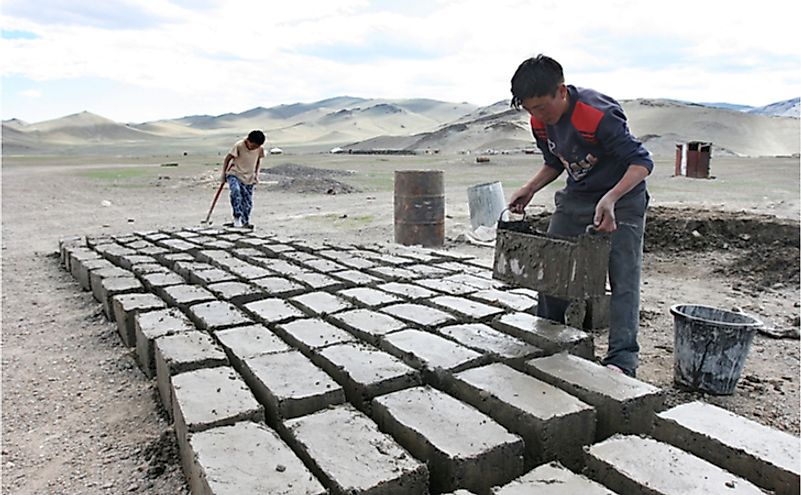What Are The Biggest Industries In Mongolia?

Mongolia is a landlocked country located between China and Russia. It has a 3,485-kilometer border with Russia and a 4,670-kilometer border with China. The capital city of Mongolia is Ulaanbaatar. Mongolia has an estimated area of 1.57 million square kilometers. It is the eighteenth largest country in the world with a population of only about three million people. The official language spoken in Mongolia is Mongolian. Mongolia is sub-divided into five distinct regions based on culture, as well as geopolitical and geographical locations. The first region is Central Mongolia which includes Ulaanbaatar and Arkhangai (a popular tourist region). The second region is Eastern Mongolia which lies around the Mongolian steppe. The third region is the Gobi desert located in southern Mongolia. Northern Mongolia is the fourth region which consists of Mongolian forests and the massive Hovsgol Lake. The last sub-division is Western Mongolia that comprises of Lake Uvs Nuur and Tavan Bogd Mountains. About 40% of all Mongolians continue to lead a nomadic way of life even today. The nomads explore the rugged, beautiful gorges and mountains hunting for golden eagles, the Mongolian horse, and the desert gazelles.
Biggest Industries In Mongolia
The GDP of Mongolia is estimated to be around US$ 13.49 billion. The economy of Mongolia is anchored in the agriculture, mining, service and construction sectors.
The Construction Industry
The construction companies in Mongolia have employed over 100,000 people and at the same time created about 130,000 extra jobs indirectly. The country produces over 60% of its construction materials domestically. The other 40% is mostly imported from China. The construction sector in Mongolia covers a wide scope including residential apartments, commercial buildings, and industrial buildings. Furthermore, the sector extends its activities to include infrastructural developments such as roads and railway lines. The construction industry also engages in the power generating infrastructure like hydroelectric power stations, solar power plants, coal-fired thermal stations, as well as wind power stations. Out of the population in Mongolia, about 57% of people reside in cities creating a high demand for housing and other related facilities. In addition to this, the industrial, tourism, and service sectors also increase the construction demands especially with regards to the residential apartments, shopping complexes, hotels, offices, and recreational facilities.
The high demand for the services of the construction industry prompted the privatization of construction companies that were state-owned before the late 1990s. Currently, the companies are under the joint ownership of the private sector and the Mongolian government. This partnership between the government and the private sector has increased innovation as well as improved services within the construction industry. Presently, Mongolia consists of over 100 architectural and engineering design companies and about 1000 construction companies. These companies have been able to meet urban housing demand. Besides, the unit cost of apartments has decreased. The construction industry has created many jobs for Mongolians leading to reduced levels of poverty. To improve the living standards of Mongolians, the government is in the course of constructing about 40,000 housing units following the housing law and the National housing program. The law is part of the government’s action plan in the Ministry of Construction and Urban Development.
The Mining Sector
The mining sector in Mongolia accounts for about 21% of the GDP. The country is rich in large copper, gold, and coal deposits. The largest mining center in Mongolia is the Oyu Tolgoi (OT) Copper-Gold mine found in the southern Gobi region. This mine is partly owned by the Mongolian government (34%) and Turquoise Hill Resources (66%). Nonetheless, the management of the mine is done by Rio Tinto which owns 51% of Turquoise Hill Resources portion of the Oyu Tolgoi mine. The OT mine contains over 35 million tons of copper and about 1,275 tons of gold. As a result, this mine is among the largest gold and copper mines in the world. This mine is still expected to significantly contribute to the Mongolian GDP for another three decades in the future. OT mine began mining of copper in the year 2013. By the end of 2015, it had exported about 1.5 metric tons of copper ore to China. Presently, the OT mine produces approximately 450,000 tons of copper annually which culminates to about 3% of the world’s economy. It is estimated that the mining activities will continue for another 50 years from now. Another significant mine in Mongolia is the Tavan Tolgoi (TT) coal project. This company is believed to have coking coal deposits of 6.4 billion that are yet to be exploited.
The annual copper production in Mongolia is approximately 120,000 tons resulting in the country being ranked twelfth globally with regards to copper reserves. Both the OT and TT mining companies have coal reserves of about 162 billion metric tons of high quality and high heat content coals. The coal deposit reserves stretch across 1.5 million square kilometers of the south Gobi desert where about 6.4 billion tons of coal is extracted. Part of this coal is used to generate energy in Mongolia. In addition to the three top minerals mined in Mongolia, other minerals include molybdenum, fluorspar, zinc, tungsten, tantalum, niobium, yttrium, thorium, zircon, iron and uranium. The Mongolian fluorspar ranks fifth globally and includes the production of both acidic and metallurgical grades of the mineral.
The Agricultural Sector
The agricultural sector accounts for more than 20% of Mongolia’s GDP and 14% of foreign exchange revenues. In 2008, there were a total of 42.8 million heads of livestock in Mongolia which represented 85% of the total agricultural production. The animals kept in the country include cattle, horses, camels, sheep, goats, and pigs. Crop production is also a significant part of agriculture in Mongolia. The crops produced include potatoes, barley, corn, and wheat. A national program known as “The Third Crop Rehabilitation Campaign” was initiated to intensify crop production, increase food security and safety, eliminate import dependence, and increase agricultural production.











